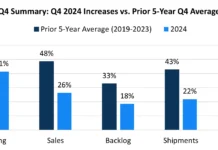by Teri M. Samples, CPA and Michael J. Devereux II, CPA, Mueller Prost
After nearly a decade of issuing a long series of proposed and temporary regulations, the IRS finally has issued final regulations providing guidance to help taxpayers determine how to treat repair and maintenance expenditures related to tangible property from a tax perspective.
Such property includes buildings, machinery, equipment and vehicles, as well as costs incurred to replace major components or substantial structural parts of a unit of property (UOP). It also includes expenses that result in a UOP’s betterment, restoration or change in use.
The final regulations (IRS T.D. 9636, also known as the Repair Regs) help clear up the confusion that has existed for many years with regard to whether taxpayers can expense and deduct repair and maintenance costs, or if they must capitalize these expenditures. Property and costs that are expensed generally can be deducted in the year they are paid or incurred, but those that are capitalized must be depreciated and deducted over a period of years. Therefore, expensing usually is preferred by most taxpayers.
Separating repairs from improvements
Internal Revenue Code (IRC) §162 and §263 distinguish between “repairs” and “improvements” in determining whether taxpayers can expense and deduct tangible property expenditures or must capitalize and depreciate them. Expenses allocated to acquiring, producing and improving tangible property must be capitalized and depreciated over the appropriate useful life, while those allocated to incidental repairs and maintenance can be expensed and deducted as paid or incurred.
The Repair Regulations provide clarification to help taxpayers make this distinction. They allow a taxpayer to deduct routine maintenance costs, which are defined as recurring activities that are necessary to keep the property in “ordinarily efficient operating condition.” These activities – which include inspection, cleaning, testing and replacement of worn and damaged parts – should be expected to be performed more than once during the propertys alternative depreciation system (ADS) life.
Note that in the case of commercial and residential real estate, the measurement period is 10 years. Therefore, such activities should be expected to be performed more than once every 10 years.
If non-inventory materials and supplies are used to perform the routine maintenance, they can be deducted under specific conditions. Fuel, lubricants, water and similar items consumed within one year are deductible, as are UOPs with a useful life of no more than one year and those with an acquisition or production cost of no more than $200.
Incidental materials and supplies, such as mold cleaning materials, can be deducted as soon as they are purchased. But, non-incidentals may not be deducted until they actually are used or consumed; these include things like press parts and end-of-arm tooling parts, for example. Further, rotable, temporary and standby emergency spare parts cannot be deducted until they are disposed.
Expenses that must be capitalized
Meanwhile, the Repair Regulations define acquiring, producing or improving tangible property as any activity that results in one of the following:
- A betterment of the property. It corrects a pre-existing defect or causes a material increase in capacity, productivity, efficiency, strength, quality or output.
- A restoration of the property. It returns a unit of property to ordinarily efficient operating condition after it had deteriorated and was no longer functional.
- An adaptation of the property. It makes it possible to use the asset for a new or different purpose.
If an expense meets any one of these criteria, it cannot be expensed and deducted – it must be capitalized and depreciated over a period of years.
The following examples help illustrate how the Repair Regulations might apply in typical scenarios.
- Suppose the compressor unit in a commercial building’s air conditioner has failed and needs to be replaced. Would this be considered a repair or an improvement to the air conditioning system? While on the surface it might seem like this would be a repair that can be expensed and deducted, it actually would depend on the facts and circumstances. Assuming the compressor was replaced with a more efficient unit, this would be considered a restoration or betterment and, therefore, must be capitalized and depreciated.
- On the other hand, if the taxpayer had 10 rooftop units and two were replaced and no work was performed on the others or the controls, these would be expensed as they do not constitute a major component or substantial structural part of the building unit.
- Suppose key parts of 55-ton press are damaged and need to be replaced. This likely would qualify as a repair that can be expensed and deducted during the year when the repair is made.
For commercial buildings, the repair standards must be applied separately to the overall structure, as well as to the following specific building systems:
- HVAC
- Plumbing
- Electrical
- Escalators
- Elevators
- Fire protection equipment
- Security equipment
- Gas distribution systems
Safe harbors for taxpayers
The Repair Regulations contain a safe harbor for taxpayers with gross receipts up to $10 million. These taxpayers can elect to expense and deduct (rather than capitalize) repairs, maintenance and improvements if the building’s initial cost is $1 million or less and the total expenses for the tax year do not exceed $10,000 or two percent of the unadjusted basis, whichever is less.
In addition, the Repair Regulations also provide a de minimis safe harbor of $5,000 for taxpayers that prepare applicable financial statements (these include audited and certain other government-required statements). Further, certain taxpayers can expense up to $500 per item if a written expenses policy was in place at the beginning of the tax year.
Coordination with research expenditure regulations
On July 18, 2014, the Treasury Department finalized regulations with respect to research expenditures (see the August 4, 2014 Plastics Business Blog post at www.plasticsbusinessmag.com/blog). Research expenditures, like repair and maintenance expenditures, may be deducted in the tax year in which they are paid or incurred. As part of this process, plastics manufacturers should consider whether the activities associated with internally developed machinery or equipment meets the definition of research.
Applicable dates
The Repair Regulations apply to tax years beginning on or after January 1, 2014. They are retroactive, so you may need to adjust for prior years’ repairs and maintenance costs that were capitalized incorrectly. The good news is that this adjustment could result in a current deduction equal to the un-depreciated cost of previously capitalized repair and maintenance expenses.
Steps to take
Mueller Prost suggests the following actions:
- Review and update depreciation schedules and calculations.
- Review fixed asset files and determine if expenditures have been properly classified as a repair expense vs. capital asset.
- Compare allowable depreciation to what has been previously reported on prior years’ tax returns.
The impact
The Repair Regulations likely will have some kind of impact on virtually every business, including the need to change how businesses account for repair and maintenance costs. In fact, most taxpayers will benefit from changes in their accounting method(s), and these changes will result in significant new recordkeeping, administrative and documentation requirements.
Teri M. Samples, CPA and Michael J. Devereux II, CPA, are partners at Mueller Prost, a CPA and business advisory firm. Samples leads Mueller Prost’s Real Estate Services group, while Devereux leads Mueller Prost’s Plastics Industry Services group. Both authors focus on tax incentives available to taxpayers. Mueller Prost’s Tax Incentives Group is nationally recognized and has assisted hundreds of companies in the manufacturing sector to identify and utilize these incentives. Mueller Prost is a member of MAPP and offers MAPP members three hours of complimentary tax and accounting advice. For more information, call 314.862.2070 or email mdevereux@muellerprost.com.




